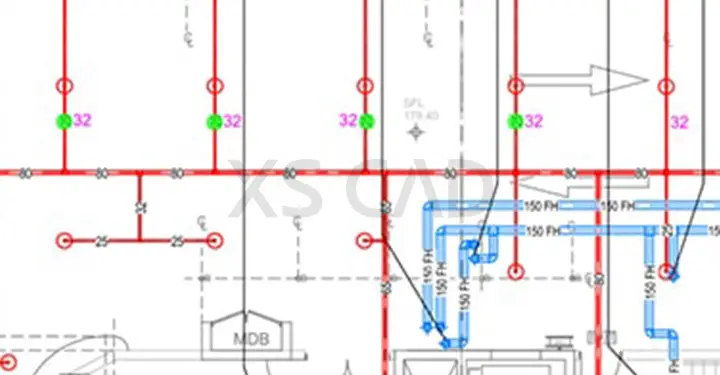Our Articles

Planning & Documentation for Hospital Fire Design
With regular technological advances in medical science and the resulting addition of various equipment to healthcare facilities, hospital design has had to adapt. Paying careful attention to fire systems design in hospitals becomes crucial, and that involves precise knowledge of potential hazards in hospital premises and the codes and documentation governing fire systems design. Fire design services providers need to be thorough in both aspects.
There are some parts of hospitals that have a higher risk of fire. These areas need special treatment. They should be well segregated from the other parts of the hospital and have dedicated fire suppression systems, such as wet chemical systems in kitchen hoods, powder extinguishing systems protecting gasoline burners in boiler rooms, gas extinguishing systems on power generators, etc. High-risk locations on hospital premises include:
Laboratories
Expensive equipment in laboratories and clinical diagnostics in modern hospitals are at high risk of being damaged in fires. Fires can start with heated up strip conductors and cables or by the careless handling of chemical substances. Water used on this kind of equipment may cause permanent damage. Patients would be adversely affected and would miss out on critical treatment and diagnostic procedures. Therefore, non-toxic gases, such as argon and nitrogen, can be used to extinguish fires in such areas without leaving any residue.
Operating Theatres, Treatment Rooms
It is possible for short circuits in the complex medical equipment of operating theatres and treatment rooms to start fires. Equipment such as these could malfunction and affect patient lives.
Cable Rooms and Galleries
Hospitals require many cables, either for power supply or data transmission. These cables are routed along ducts and are collected in cable rooms or galleries. When these cables overheat, the overheated insulation may lead to short circuits, resulting in great loss to electrical installations and possibly entire departments.
Vital hospital areas, services and functions can be adversely affected, and the traditional extinguishing methods may not be effective in stopping the spread of the fire.
Smoke detectors, smoke suction systems and heat detectors can be used to detect fire in curving, difficult to access cable channels. Low–pressure water mist systems can be effective for existing and new cable channels.
Waste Disposal Areas
Hospitals generate a sizeable amount of organic and inorganic waste daily. Waste which is not separated properly is in danger of igniting. This can be monitored by an automatic extinguishing system. Sprinklers and water sprays with open nozzles are some of the options that can be used on chemical material.
Key Hospital Areas that Need Firefighting Solutions
- Operating Theatres
- Canteens
- Patient Rooms
- Car Parks
- Staff Facilities Rooms
- Laundry Rooms
- Offices
- Archives
- Server Rooms
- Pharmacy/Shops
- Glass Corridors
- Storage Areas
- Consultation Rooms
- Underground Ambulance Areas
- Highly Sensitive Equipment Rooms
- Reception Areas
- Kitchens & Ducts
- Emergency Generator Rooms
- Corridors
- Lobbies & Waiting Rooms
Areas with Heat-producing Appliances
- Boiler rooms
- Kitchens
- Incinerator rooms
- Generator rooms
- Laundries
- Autoclave rooms
Areas with High Fire Load
- Employee locker rooms
- Gift shops (larger than 50 sq.m.)
- Laboratories
- Car parking areas
Since fire systems design is crucial for the effective functioning of the hospital premises, the design documentation has to be near perfect. Fire systems engineers, MEP designers and HVAC mechanical engineering consultants must anticipate conditions for fire, plan clear exits and plan for effective fire suppression systems. This takes specialised skill and expertise. The documentation that is produced is not only used for manufacture and installation of equipment, but also for maintenance and facilities management purposes. The various plans and documents produced by the fire design engineer are discussed below.
Documents Required for Fire Systems Design
Fire Safety Master Plan
This plan details fire safety data integrated in the building. Ideally, all fire risks, codes, standards, regulations and mitigation measures are included.
Topics covered should include:
- Fire prevention
- Fire suppression and control
- Means of egress
- Emergency response plan
- Detection and alarm systems
- Operation and maintenance
- Compartments
Regular updates are required for the plan that should take into account significant building changes, modifications and alterations. Additional fire safety procedures may be necessary.
Fire Safety Design Documentation
Additional detailed information on installed fire systems must be part of this documentation, such as:
- As-built systems plans
- Supplier list
- Calculations of verifications
- System certificates
- Components’ data sheets
- Design documentation of fire safety
- Spare parts list
Emergency Response Plans
This plan entails staff responsibilities in case of a fire. Hospital patients are in various levels of physical disability and transporting them out of the healthcare facility may be extremely difficult. As patients who cannot move or move with difficulty are most vulnerable to the effects of a fire, the emergency response plan focuses on them first and how to distance them from the fire. Secondly, evaluations must be conducted to determine if further evacuation is required.
These plans should detail:
- Alarms
- Alarm transmission to fire department
- Emergency call to fire department
- Response to alarms
- Isolation of fire
- Evacuation of immediate area
- Evacuation of safe refuge area
- Preparation of floors for evacuation
- Fire extinguishment
Fire system design is a very specialized element of the overall building engineering design, and most firms either employ in-house specialists who focus solely on fire design or alternatively they employ external fire design specialists. As resources for these specialist roles become more and more scarce, many of these in-house or external specialists are now using offshore design partners to handle elements of the hospital’s detailed fire systems design documentation. With the right technical know-how and relevant experience, cost-effective overseas firms can deliver professional, high-quality electrical design services, hydraulics and plumbing design services and fire systems design and documentation support to allow projects to be managed within budget and on time.

